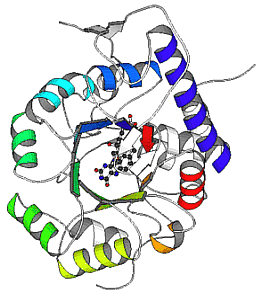
The function of macromolecules in a cell differs fundamentally from that of the small molecules. Macromolecules are generated by the polymerization of small monomeric subunits. Several classes of macromolecules have a special importance for the cell:
![]() polysaccharides,
polysaccharides,
![]() polypeptides
or proteins
polypeptides
or proteins
![]() nucleic
acids.
nucleic
acids.
In all three classes, numerous different combinations would theoretically be possible. Instead, their actual number in the cell quite is clear. This is on one hand due to the limited amount of monomers and on the other caused by the fact that specific enzymes are needed for each type of linkage. Cells contain enough enzymes but these are subject to selection and are thus reduced to the amount absolutely necessary. Especially polysaccharides show that only a very limited range of final products is generated. Many polysaccharides are built from only one type of monomer leading to uniformity and regular molecule structures. The resulting molecules are particularly well suited for the formation of large organized structures like, for example, cell walls; other polysaccharides are stored for future use. A third category of polysaccharides is composed of different monomers and can be found in the matrix of cell walls and at the cell surface causing the different specific surface characteristics of cells.
The number of possible polypeptides depends on the number of genes that are used by the cell since the sequence of polypeptide chains is encoded by genes. Due to the different reactivities of the amino acid residues in proteins, specific three-dimensional structures develop. Many of these structures are enzymes that catalyze specific reactions.
Nucleic acids, finally, are the carriers of genetic information. Two conditions have to be fulfilled to store and replicate information: the polymer has to be constructed from monomers in a determinable order, a condition that is satisfied by both nucleic acids and proteins but not by polysaccharides, and the molecule has to be able to replicate identically. This requirement is only met by nucleic acids.
Extensive image material, molecular models and atomic coordinates of proteins, nucleic acids, carbohydrates, nucleotides and molecular complexes can be found on the server of the Institut für Molekulare Biotechnologie Jena (The Image Library of Biological Macromolecules, The RNA World etc.):
|
|